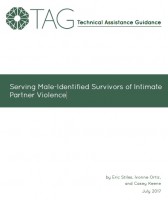Resources Library: Model Policies & Best Practices
Start a Search:
SAFE RETURN: Working Toward Preventing Domestic Violence When Men Return from Prison
The Safe Return Initiative focuses on strengthening domestic violence services for African American women and their children when they are facing the return of an intimate partner from prison. It does this by building culturally specific technical capacity within and cooperation among justice institutions and community-based and faith-based organizations. Its goals are to keep women and their children safe and improve the odds of successful reentry by offering peer-based learning, training, information sharing, and on-site assistance designed to help criminal justice and community-based
organizations better serve African Americans dealing with prisoner reentry.
Sample Supplemental Domestic Violence and Strangulation Report Forms for Law Enforcement
These documents are samples of supplemental report forms that law enforcement agencies can use when documenting domestic violence and/or strangulation incidents. These forms are samples and intended to provide a framework that and local law enforcement agencies and community teams can adapt for their own use.
Securing Devices and Accounts - a new resource from NNEDV and Norton

NNEDV is excited to announce a new resource in partnership with Norton (yes, the folks who do data security). Their new resource "Securing Devices and Accounts" is a privacy-and-security-focused guide for survivors of abuse, stalking, and other gender-based violence.
You can read more about the partnership and the resource launch on Norton’s blog and download the resource below.
Serving Male-Identified Survivors of Intimate Partner Violence

"Historically, domestic violence programs were born from the women’s liberation movement of the 1970s to address the needs of female survivors, who still represent the majority of victims seeking services today. Generally, the domestic violence movement has framed its work on a gender binary with men as perpetrators and women as victims. We have come to learn, however, that a woman-centered approach to advocacy only addresses the needs of a portion of survivors and largely fails to acknowledge and address male victimization."
A resource developed by the National Resource Center on Domestic Violence, this Technical Assistance Guidance supports advocates seeking to build capacity to recognize and respond to survivors across the gender spectrum, while honoring the gender analysis that helps us understand the root causes of violence and oppression.
Sexual Assault Demonstration Initiative - Publications and E-Learning Tools
As originally published by the National Sexual Violence Resource Center, the Sexual Assault Demonstration Initiative (SADI), the first large scale project of its kind, was created to enhance sexual assault outreach, services, and community partnerships in dual/multi-service programs. Six sites across the nation engaged in a four-year process of assessment, planning, and implementation of new and enhanced services and organizational capacity building. The materials that were developed based on the lessons learned across project sites can be found at https://www.nsvrc.org/sexual-assault-demonstration-initiative, many of which are avaiable in English and Spanish.
Topics include:
- - Foundations of Advocacy
- - Culturally Relevant Services for Tribal Communities and Communities of Color
- - Picturing Your Program: Planning for Organizational Growth
- - Listening to Survivors - Essential Steps for the Intake Process
- - Comprehensive Services for Survivors of Sexual Violence
- - Throw Away the Menu: Broadening Advocacy
- - It Matters! How Defining Sexual Violence Defines Advocacy Programs
- - Building Cultures of Care
- - Listening to Our Communities: Assessment Toolkit
- - Trauma-Informed Care
- - Lessons for Local Programs & SADI Timeline Overview
-
- and the Final Report
What is the Sexual Assault Demonstration Initiative (SADI) - Watch this brief overview to learn more about the Sexual Assault Demonstration Initiative (SADI) and the lessons learned from this national project.

